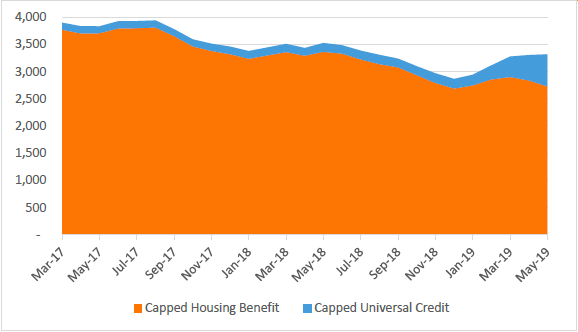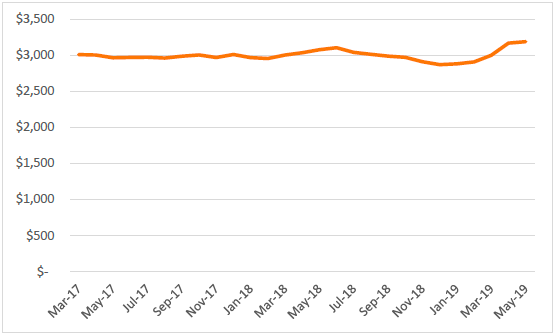Welfare reform - housing and social security: second follow-up paper
A report following the 2019 Annual Report on Welfare Reform focusing on the impact of UK Government Social Security policy on housing.
3. UK Government welfare reforms
Local Housing Allowance
In the private sector the most significant reform has been the changes to Local Housing Allowance rates and there is a further chapter on its impact in this report. Local Housing Allowance rates are set in relation to market rents across eighteen Broad Rental Market Area's (BRMA) in Scotland, and across five bandings reflecting accommodation size, ranging from the cost of sharing accommodation or leasing a single room to the cost of rent on a home with four or more bedrooms. These rates are used to set the maximum payable under housing benefit. The rate payable is set in relation to household size, not the property itself. The lowest rate is the Shared Accommodation Rate (SAR) available to single adults under the age of 35 without dependents.
The levels are set for a financial year, and the 2019/20 rates are the fourth set of rates to be frozen. The freeze on uprating was announced as a policy for four years, and it had been announced that the freeze to benefits generally will come to an end. However, no announcement has been made that would indicate any plans to reverse the real terms cuts to LHA rates. As noted previously, coupled with the unpredictability of rents, it is impossible to accurately forecast the future impact of LHA policy. There is an update on the impact of the freeze on LHA rates in part five of this report.
Universal Credit
There is some evidence that UK Government welfare reforms generally, and the roll out of UC in particular, has increased the risk of rent arrears, and this relationship is the focus of a fuller chapter later in this report. UC is now fully rolled out across Scotland for new claimants and people in receipt of legacy benefits reporting a change to their circumstances. There is concern that any problems associated with UC could be exacerbated as people are migrated across to UC, starting this year.
As mentioned in the last report, Local Authorities and landlords have also reported that it is harder to support households in receipt of UC, and this causes difficulty in the processing of DHPs, Scottish Welfare fund (SWF) applications and Council Tax Reduction (CTR), compared to households in receipt of Housing Benefit.
The Scottish Government continues to take steps to mitigate these practical difficulties. For example the CTR scheme is currently in the process of being revised with the objective of using information captured by DWP for UC cases to make sure councils can deliver the same level of CTR as would be the case if they were on legacy benefits.
Bedroom Tax
The Scottish Government continues to mitigate the bedroom tax in full. Without Scottish Government intervention the bedroom tax would affect over 70,000 households. The Scottish Government budgeted £52.3m in 2019/20 to fully mitigate the impact of this welfare reform. The UK and Scottish Governments have a long standing agreement in principle that this will be mitigated at source through Universal Credit, although no date for implementing a change to UC has been agreed as yet. In the meantime mitigation will continue to be administered through the use of Discretionary Housing Payments. Administering the mitigation for tenants in receipt of UC (as opposed to the legacy housing benefit) is more difficult and time consuming.
Benefit Cap
The Benefit Cap was introduced in 2013, and is intended to set a maximum amount of means-tested benefits a household can receive. Where a household’s total means-tested benefit entitlement is higher than the benefit cap threshold, its Housing Benefit (HB) or Universal Credit (UC) payment will be reduced until total means-tested benefit payments do not exceed this maximum amount.
Originally the cap’s main threshold was set at £26,000 annual gross household income (for couples and households with children), with a lower £18,200 for single people without children. In November 2016 the cap was reduced to its current threshold in Scotland, of a £20,000 main rate, and £13,400 for single people without children. The reduced threshold led to many more people having their benefits capped, and the DWP estimates that in May 2019 around 94% of Scottish households with capped legacy benefits (for whom data is available) would not have been affected if the cap remained at its original, higher level.[16]
Official statistics from May 2019 show that average weekly Housing Benefit awards in Scotland were higher in the private sector (£96 per week) than they were in the social rented sector (£78 per week). Nonetheless, across Scotland just over 70% (1,919) of households with capped Housing Benefit lived in the social rented sector in May 2019, while the remaining 30% lived in the private sector. Among these 1,919 social housing tenants households with capped Housing Benefit, almost 65% (1,240) were local authority tenants, while 35% (682) were tenants of a registered social landlord.
How the Benefit Cap caseload is changing over time
A total of 3,320 Scottish households were benefit capped as of May 2019. The cap disproportionately affects families with children. Based on the most recent data, covering May 2019 of the 2,730 households whose Housing Benefit has been capped, two thirds (1,820) were lone parent households and only 9% (270 households) were not responsible for children. Of the 91% of households which contain children, 87% are large families which care for three or more children.
Among Housing Benefit-capped families, the average amount capped each week was £64, equivalent to around £3,320 per year. Among households with either capped UC or Housing Benefit, most of those who are capped (1,820) lose up to £50 a week, however a substantial number (1,480) lose more than that.
In Scotland the Benefit Cap caseload i.e. the number of households affected by the policy, has exhibited a slow decline, decreasing around 15% between its mid-2017 peak[17] and the most recently available May 2019 data, as shown in Figure 1.
Figure 1 – Scottish Benefit Cap caseload over time, by benefit capped

Source: Stat-Xplore
This reduction in caseload has not been matched by a decrease in amount lost to each household; the average amount lost through the cap has remained around £3,000 over this time period, as shown in Figure 2.
Figure 2 – Average annual amount lost by capped Scottish households over time

Source: Scottish Government analysis based on Stat-Xplore data
At the same time, homelessness applications in Scotland reached around 36,500 in 2018/19[18], which is just over ten times the level of Benefit Cap caseload. Across applications which provided the reasons for no longer having accommodation, 19% cited financial difficulties, debt or unemployment as a contributing factor.
The Benefit Cap, as a policy that reduces the ability of low-income households to afford housing costs, could be expected to increase the risk of homelessness. However, Benefit Cap data produced by the DWP cannot currently be linked to official homelessness statistics, and therefore we are unable to estimate to what extent the cap is increasing homelessness in Scotland.
Considering, however, that the cap may be a contributing factor for some households becoming homeless, we will continue to monitor the available data to help us understand by how much the Benefit Cap drives homelessness in Scotland.
As mentioned elsewhere in this report, the UK Government has announced that the benefits freeze is to come to an end[19] with benefits to uprated in line with inflation from 2020. However no equivalent announcement has been made in relation to the cap. This means that there is a real risk to some families that uprating of benefits will bring them up to capped levels of income, reducing or eliminating the potential benefits to them from the reversal of the freeze.
Support for mortgage interest
As mentioned in the previous report, owner occupiers with mortgage costs are eligible for Support for Mortgage Interest (SMI). This was formally administered as a benefit, but since April 2018 is now available as a loan scheme. The eligibility criteria for SMI is more limited than that for support with rental costs through either housing benefit or UC, especially for working age households, who need to wait 39 weeks after claiming a passporting benefit (such as UC or Job Seekers allowance (JSA)), and will need to be entirely out of work. The change is expected to affect between 10,000 and 20,000 households in Scotland, reducing Social Security spending by £20 million per year by 2020/21. Latest statistics show that across the UK, as of September 2019 around 21% of claimants eligible for SMI have accepted an offer of a loan.
Contact
Email: merlin.kemp@gov.scot
There is a problem
Thanks for your feedback